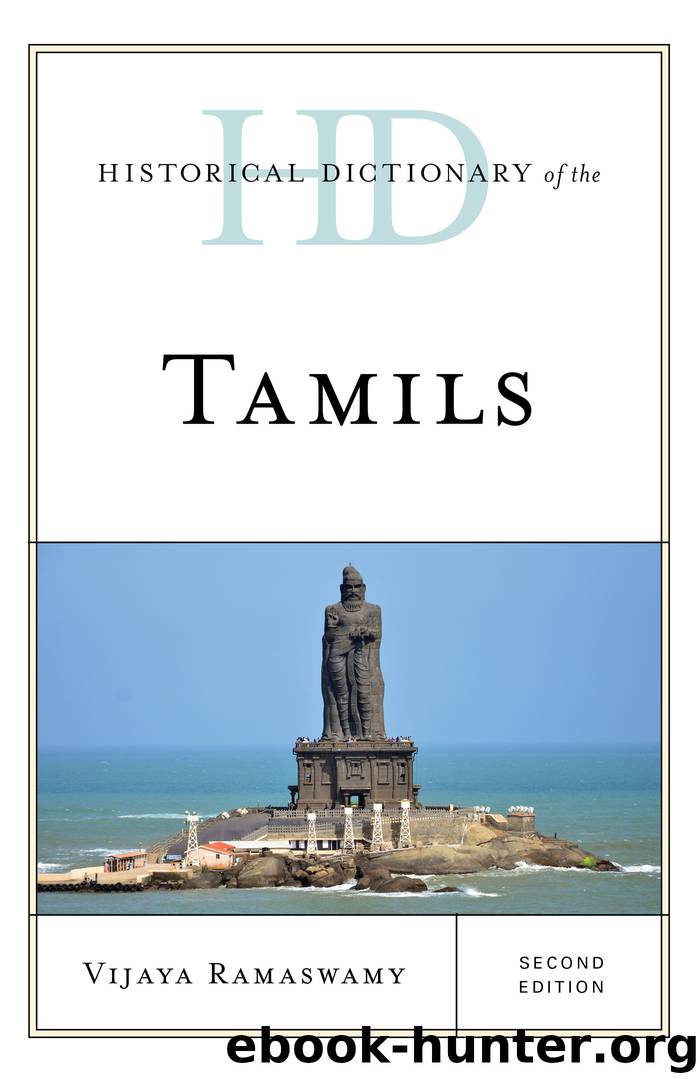Historical Dictionary of the Tamils by Vijaya Ramaswamy

Author:Vijaya Ramaswamy
Language: eng
Format: epub
Tags: undefined
Publisher: Rowman & Littlefield Publishing Group, Inc.
Published: 2012-03-20T16:00:00+00:00
MANIMEKALAI
This late-Sangam and post-Sangam work is ascribed to Sittalai Sattanar and was probably composed around the 5th century CE. The heroine of this Buddhist text is Manimekalai, the daughter of Madhavi, who is portrayed as the “other woman” in Ilango Adigal’s Silappadikaram. Due to the connectivity and intertextuality between the two texts, they are known as twin epics.
The heroine, Manimekalai, belongs to the courtesan (Parataiyar) caste but is brought up by her mother, Madhavi, as a Buddhist and is trained in the path of renunciation. The epic describes the attraction of Prince Udayakumaran (who was her husband in her previous birth) toward the beautiful Manimekalai. She is, however, saved from a life of sensual satisfaction and material pleasures through the guidance of the goddess who is also named Manimekalai. At the island of Manipallavam, the knowledge of her past and future births is revealed to her. The goddess bestows on her the amudasurabhi, which, like the Holy Grail, is sacred and always filled with alms. Prince Udayakumaran is murdered while he is in pursuit of Manimekalai. The epic concludes with her accepting a life of asceticism. As a wandering monk, Manimekalai defeats many Buddhist and Hindu theologians in debates. Starting out as a member of that community of courtesans who serve as objects of sexual gratification, Manimekalai transcends worldly desires and becomes the symbol of universal love and compassion. See also .
Download
This site does not store any files on its server. We only index and link to content provided by other sites. Please contact the content providers to delete copyright contents if any and email us, we'll remove relevant links or contents immediately.
| Dictionaries | English |
| Foreign Language Dictionaries & Thesauruses | Lexicography |
| Slang & Idioms | Synonyms & Antonyms |
| Thesauruses |
A Dictionary of Sociology by Unknown(3016)
The Art of Dramatic Writing: Its Basis in the Creative Interpretation of Human Motives by Egri Lajos(3014)
The Dictionary of Body Language by Joe Navarro(2946)
0041152001443424520 .pdf by Unknown(2783)
How The Mind Works by Steven Pinker(2729)
Day by Elie Wiesel(2717)
Merriam-Webster's Collegiate Thesaurus, Second Edition by Merriam-Webster Inc(2710)
The Meaning of the Library by unknow(2503)
The Official Guide to the TOEFL Test by ETS(2285)
A History of Warfare by John Keegan(2183)
The Emotion Thesaurus: A Writer's Guide to Character Expression by Puglisi Becca & Ackerman Angela(2121)
Emotion Amplifiers by Angela Ackerman & Becca Puglisi(2006)
MASTER LISTS FOR WRITERS: Thesauruses, Plots, Character Traits, Names, and More by Bryn Donovan(1906)
The Cambridge Guide to English Usage by PAM PETERS(1880)
Merriam-Webster's Pocket Dictionary by Merriam-Webster(1880)
Star Wars The Rise of Skywalker The Visual Dictionary by Pablo Hidalgo(1840)
Lucky Jim by Kingsley Amis(1697)
American Accent Training by Ann Cook(1635)
Word by Word by Kory Stamper(1613)
